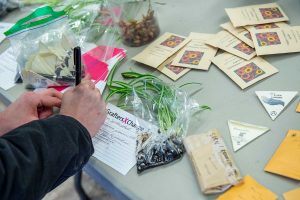Huddled together outside Schupf Arts Studios, 51·çÁ÷ students and local ecology enthusiasts took turns hammering away at the ground, chiseling out a hexagon-shaped piece of asphalt. Removing the asphalt airs out the soil below, eventually creating a small island ecosystem and helping heal the land that has accumulated toxicity in being paved over.
This was one of the events during a two-day gathering titled Grafters X Change: Branches and Networks in late March. The event brought together 51·çÁ÷ and local community members, eco-artists, and activists to foster creative community resiliency.
Assistant Professor of Art and Art History Margaretha Haughwout conceived of the event after moving from the San Francisco Bay Area last year. There, she co-created the Guerrilla Grafters, a collaborative art-activist group that grafts fruit onto non-fruit bearing trees in urban areas to provoke conversations about food accessibility and the urban commons. Here in central New York, she invited artists and ecologists from the surrounding area to share their knowledge and address agricultural issues as a community through the scion exchange.
“I’m interested in getting folks to share the stories of where their scion wood is coming from,” she said. “So when we’re grafting onto a new tree, we’re not only getting the branch, but we’re also getting a history of a community or location.”
As such, community members brought in labeled scions from their orchards, and attendees took them home to graft onto their own trees, allowing their orchards to produce increased varieties of fruit.
When we’re grafting onto a new tree, we’re not only getting the branch, but we’re also getting a history of a community or location.
The seed exchange, also ongoing throughout the event, was a collaboration between students in Haughwout’s Digital Studio Art: Distribution and Intervention course, Professor of Art and Art History Lynn Schwarzer’s Printmaking course, and artist Dawn Weleski, who has been working on a socially engaged project (titled “Out of Pocket”) regarding seeds in the area. The professors gave their students the opportunity to collaborate with Weleski to tackle the prompt: How would you seed change?
Students designed packets for a seed that might act as a metaphor for or potential solution to a political issue. Topics ranged from mental health issues to the abundance of plastics in the ocean.
Tristan Gardner ’19 designed a seed packet for the three main agricultural crops of indigenous communities: corn, squash, and beans, which are planted together because corn saps nutrients from the soil while beans replace them. The crops are referred to as the Three Sisters when planted together.

Photo by Mark DiOrio
“The Three Sisters is about the broken food system and how a lot of the people who are producing food are the ones left hungry at the end of the day,” Gardner says. “Three sisters are symbiotic, which is the idea of the food system when you think about growers, consumers, and government subsidies — if you do it wrong, one overtakes the other.”
It was clear, as participants trekked to Sherburne to spend Saturday continuing to discuss the Anthropocene and climate change, that attendees from all backgrounds shared an interest in learning from one another and trying to bring back a respect for land and community.
After seeing the enthusiasm for this year’s event, Haughwout plans to continue the exchange annually. “There’s an obligation when you start reaching out to larger communities,” she says. “[The exchange] is first and foremost a socially engaged project, and when the intention is for greater community resilience, you have to keep doing it.”
